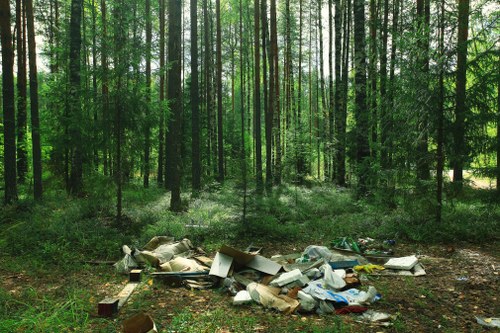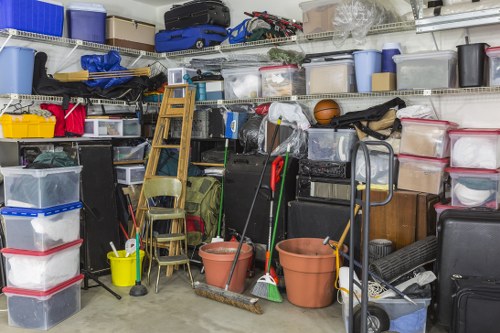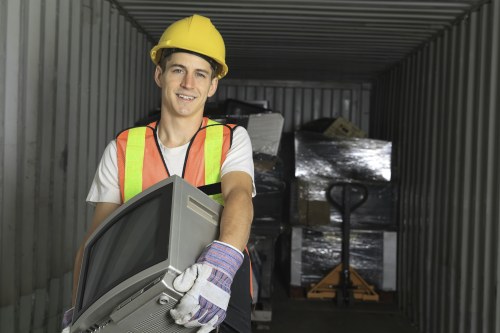Comprehensive Guide to Construction Waste Clearance in Abbey Wood
Understanding Construction Waste Clearance

Construction projects inevitably generate significant amounts of waste. Effective construction waste clearance in Abbey Wood is essential not only for maintaining a clean and safe site but also for promoting environmental sustainability.
Proper waste management helps contractors comply with local regulations, reduces the environmental impact, and can even lead to cost savings through recycling and proper disposal methods.
Abbey Wood, being a rapidly developing area, has seen a surge in construction activities. This increase necessitates efficient waste clearance solutions to handle the growing volume of debris and materials.
Types of Construction Waste

Construction waste encompasses a variety of materials, each requiring specific handling and disposal methods. Common types include:
- Concrete and Masonry: Often recycled into aggregate for new construction projects.
- Wood Debris: Can be repurposed or processed into biomass fuel.
- Metals: Highly recyclable and valuable for scrap metal industries.
- Waste Plastics: Require specialized recycling processes to prevent environmental contamination.
- Hazardous Materials: Such as asbestos or lead-based paints, necessitating careful removal and disposal.
Understanding the types of waste generated is crucial for implementing effective clearance strategies and ensuring compliance with local regulations in Abbey Wood.
Implementing a comprehensive waste management plan can significantly mitigate the environmental impact of construction activities.
Regulations and Compliance

In Abbey Wood, construction waste clearance must adhere to specific local and national regulations. Compliance ensures that waste is handled responsibly, reducing the risk of fines and legal issues.
Key regulations include:
- Environmental Protection Act: Governs the disposal and recycling of construction waste.
- Local Council Requirements: Specific to Abbey Wood, including permits for waste collection and disposal.
- Health and Safety Standards: Ensuring safe handling and transportation of hazardous materials.
Ensuring compliance not only avoids legal repercussions but also promotes sustainability within the construction industry.
Partnering with certified waste clearance companies can help navigate these regulations effectively.
Benefits of Professional Waste Clearance Services

Opting for professional construction waste clearance in Abbey Wood offers numerous advantages:
- Efficiency: Experienced teams can remove waste quickly and effectively.
- Cost-Effective: Reduces overall project costs by minimizing delays and handling fees.
- Environmental Responsibility: Ensures proper recycling and disposal, reducing the project's carbon footprint.
- Safety: Professional handling of hazardous materials minimizes risks onsite.
Leveraging professional services allows construction firms to focus on their core activities while ensuring waste is managed appropriately.
Moreover, it enhances the overall reputation of the business as environmentally conscious and compliant.
Steps in Construction Waste Clearance

The process of construction waste clearance involves several key steps to ensure efficiency and compliance:
- Assessment: Evaluating the types and quantities of waste generated.
- Segregation: Sorting waste into recyclable, reusable, and non-recyclable categories.
- Collection: Removing waste from the construction site using appropriate vehicles.
- Transportation: Moving waste to designated recycling centers or disposal facilities.
- Disposal: Ensuring waste is disposed of in accordance with local regulations.
Each step requires meticulous planning and execution to ensure the process is seamless and compliant with all regulations in Abbey Wood.
Implementing these steps effectively can lead to significant environmental and financial benefits.
Recycling and Reuse Strategies

Recycling and reusing materials are integral components of sustainable construction waste management. In Abbey Wood, several strategies can be employed:
- Concrete Recycling: Crushed concrete can be reused as aggregate in new construction projects.
- Metal Recovery: Metals can be separated and sold to scrap yards, reducing the need for new metal production.
- Wood Repurposing: Salvaged wood can be used in other construction projects or as biofuel.
- Plastic Recycling: Specialized facilities can process construction plastics into reusable materials.
These strategies not only reduce the volume of waste sent to landfills but also conserve natural resources and decrease overall project costs.
Adopting recycling and reuse practices is a testament to a construction company's commitment to sustainability.
Choosing the Right Waste Clearance Partner

Selecting a reliable waste clearance company in Abbey Wood is crucial for the success of your construction project. Consider the following factors when making your choice:
- Experience: Ensure the company has a proven track record in construction waste management.
- Certifications: Look for certifications that demonstrate compliance with environmental and safety standards.
- Services Offered: Assess whether they provide comprehensive services, including recycling and disposal.
- Reputation: Check reviews and testimonials to gauge customer satisfaction.
- Pricing: Compare quotes to ensure competitive and transparent pricing.
Partnering with the right company can streamline your waste clearance process and enhance overall project efficiency.
Don't hesitate to ask for references or case studies to validate their expertise in the field.
Cost Factors in Waste Clearance

The cost of construction waste clearance in Abbey Wood can vary based on several factors:
- Volume of Waste: Larger projects generate more waste, increasing clearance costs.
- Type of Waste: Hazardous or specialized materials may incur additional handling fees.
- Accessibility: Difficult-to-reach sites may require more resources for waste removal.
- Recycling Requirements: Extensive recycling efforts can influence the overall cost.
- Service Frequency: Regular clearance schedules may offer cost-saving benefits.
Understanding these cost factors helps in budgeting effectively for your construction project.
It's advisable to obtain detailed quotes from waste clearance providers to avoid unexpected expenses.
Environmental Impact of Construction Waste

Construction waste has a significant environmental impact if not managed properly. Issues include:
- Landfill Overload: Excessive waste contributes to the strain on landfill capacities.
- Resource Depletion: Improper disposal reduces the availability of recyclable materials.
- Pollution: Hazardous materials can contaminate soil and water sources.
- Energy Consumption: Producing new materials from raw resources consumes more energy than recycling.
Effective waste clearance and recycling reduce these negative impacts, promoting a healthier environment in Abbey Wood.
Adopting sustainable practices not only benefits the environment but also enhances a company's reputation.
Innovations in Waste Clearance Technology

Advancements in technology have revolutionized construction waste clearance. Modern innovations include:
- Automated Sorting Systems: Enhance efficiency in segregating materials for recycling.
- Eco-Friendly Vehicles: Reduce emissions associated with waste transportation.
- Smart Waste Management Software: Optimizes waste collection schedules and routes.
- Advanced Recycling Techniques: Improve the quality and variety of recyclable materials.
- IoT Devices: Monitor waste levels in real-time for better management.
These technological advancements streamline the waste clearance process, making it more efficient and environmentally friendly.
Embracing these innovations can lead to significant improvements in waste management practices.
Case Studies: Successful Waste Clearance in Abbey Wood

Several projects in Abbey Wood have successfully implemented efficient waste clearance strategies:
- Residential Development: Utilized a comprehensive recycling plan, reducing landfill waste by 40%.
- Commercial Construction: Partnered with a local waste clearance company to manage hazardous materials safely.
- Public Infrastructure: Employed automated sorting systems, enhancing recycling rates and operational efficiency.
These case studies demonstrate the effectiveness of strategic waste management in various construction scenarios.
Learning from these examples can guide future projects in Abbey Wood towards sustainable practices.
Tips for Effective Waste Management

Implementing these tips can enhance your construction waste clearance efforts:
- Plan Ahead: Develop a waste management plan before starting the project.
- Educate Workers: Train your team on proper waste segregation and handling.
- Regular Monitoring: Keep track of waste volumes and types throughout the project.
- Collaborate with Experts: Work with professional waste clearance services for optimal results.
- Invest in Recycling Facilities: Establish partnerships with local recycling centers to facilitate material reuse.
Effective waste management requires a proactive and organized approach, ensuring that waste clearance is seamless and efficient.
Adopting these practices can lead to significant environmental and financial benefits.
Future Trends in Construction Waste Clearance

The future of construction waste clearance in Abbey Wood looks promising with emerging trends:
- Circular Economy: Emphasizing the reuse and recycling of materials to create a closed-loop system.
- Green Building Practices: Incorporating sustainable materials and waste reduction techniques.
- Digital Transformation: Utilizing digital tools for better waste tracking and management.
- Increased Regulatory Standards: Stricter guidelines promoting responsible waste disposal.
- Collaborative Initiatives: Partnerships between stakeholders to enhance waste management efforts.
Staying abreast of these trends ensures that construction waste clearance practices remain effective and sustainable.
Adapting to these changes will be crucial for maintaining industry standards and environmental stewardship.
Conclusion

Efficient construction waste clearance in Abbey Wood is vital for the success of any construction project. It promotes environmental sustainability, ensures regulatory compliance, and can lead to significant cost savings.
By understanding the types of waste, adhering to regulations, and partnering with professional waste clearance services, construction companies can manage their waste effectively.
Embracing recycling and reuse strategies, leveraging technological advancements, and staying informed about future trends will further enhance waste management practices.
Don't let construction waste overwhelm your project. Contact us today to ensure efficient and compliant waste clearance solutions tailored to your needs.
Get Started with Your Waste Clearance Today

Managing construction waste doesn't have to be a daunting task. With the right strategies and professional support, you can ensure that your project in Abbey Wood remains clean, compliant, and sustainable.
Book your service now and take the first step towards efficient construction waste management.
Let us handle the waste so you can focus on building the future.